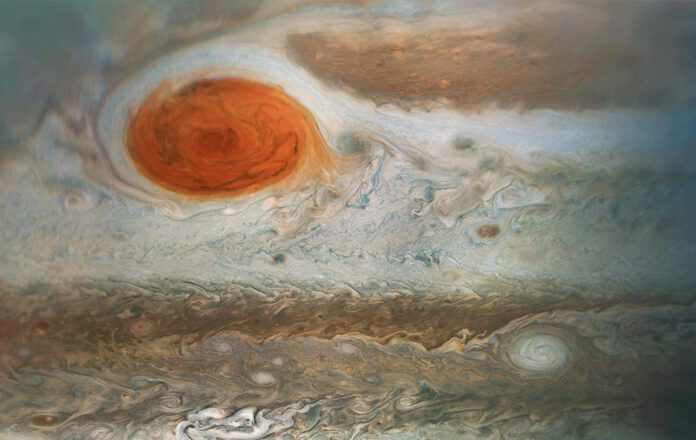
Jupiter’s Great Red Spot Remains a Mystery
Although the immense storm, with a respectable age of 190 years, remains the longest-living whirlwind in our solar system, it appears not to be the same one that astronomer Giovanni Cassini observed in 1665.
The Great Red Spot on Jupiter is the largest known atmospheric whirlwind in our solar system. Despite its prominence, its age has long been debated, and researchers still do not fully understand how this immense storm originated. A new study sheds more light on the matter and even refutes a long-held theory.
Historical Observations of the Great Red Spot
When did astronomers first observe the Great Red Spot in the night sky? There has been some disagreement on this point. In 1665, the Italian-French astronomer and engineer Giovanni Cassini discovered a dark oval shape at the same latitude as the current Great Red Spot, which he called the ‘Permanent Spot.’ However, this storm did not prove to be as permanent as its name suggested; it disappeared suddenly in 1713. Scientists did not observe a clear, oval structure at the same location again until 1831 and later years. Due to these intermittent historical observations, scientists have long debated whether the current Great Red Spot is the same as the one observed by the 17th-century scientist.
New Study Findings
To gain more insight into the development of the Spot’s size, structure, and location over time, researchers analyzed historical observations dating back to the 17th century. “It was very inspiring and motivating to study the notes and drawings made by the eminent astronomer Cassini,” said researcher Agustín Sánchez-Lavega.
The study led to a surprising discovery. “Based on our measurements of the size and movements of the Great Red Spot, we have concluded that it is very unlikely that this spot is the same as the ‘Permanent Spot’ observed by Cassini,” said Sánchez-Lavega.
A Younger Great Red Spot
In short, Jupiter’s Great Red Spot is not the same storm that Cassini observed in the 17th century. The current storm is therefore much younger than previously thought. “The ‘Permanent Spot’ likely disappeared sometime between the mid-18th and 19th centuries,” noted Sánchez-Lavega. Despite this younger age, the Great Red Spot, with an age of about 190 years, remains the longest-living whirlwind in the solar system.
Characteristics of the Great Red Spot
The researchers presented even more interesting facts in their study. They reported that since 1879, the Great Red Spot has shrunk from a long axis of 39,000 kilometers to the current 14,000 kilometers. Additionally, the storm has become somewhat more circular over time.
The Possible Origins of the Great Red Spot
But the question of how the Great Red Spot originated remains. To uncover this, the researchers conducted numerical simulations on supercomputers. They used two models to study the behavior of whirlwinds in Jupiter’s atmosphere, leading to various interesting theories. One possibility is that the Spot originated from an enormous superstorm, similar to those that sometimes form on Jupiter’s neighboring planet, Saturn. Another theory suggests the storm resulted from the merging of multiple smaller whirlwinds caused by strong wind currents that run parallel but change direction with latitude. Although both scenarios would create an anticyclone, this would differ in form and properties from today’s Great Red Spot, leading researchers to dismiss these theories. Another potential cause could be wind instability, creating an elongated atmospheric cell resembling the Great Red Spot’s shape. This could have led to the formation of a ‘proto-Great Red Spot’ that shrank over time, eventually resulting in the compact and fast-rotating Great Red Spot observed by astronomers in the late 19th century.
Future Research
Though the study has clarified some aspects, researchers are not ready to close the book on the subject. They plan future studies to investigate the shrinkage of the anticyclone over time to elucidate the physical mechanisms behind its relative stability. Additionally, they aim to determine whether the storm will eventually disappear once it reaches a certain size—possibly similar to what happened with Cassini’s ‘Permanent Spot’—or whether it will stabilize at a certain size and persist for many more years.











